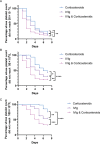Efficacy and Safety Analysis of Combination Therapy Consisting of Intravenous Immunoglobulin and Corticosteroids versus Respective Monotherapies in the Treatment of Relapsed ITP in Adults
- PMID: 37228869
- PMCID: PMC10205395
- DOI: 10.1055/s-0043-1769087
Efficacy and Safety Analysis of Combination Therapy Consisting of Intravenous Immunoglobulin and Corticosteroids versus Respective Monotherapies in the Treatment of Relapsed ITP in Adults
Abstract
Objective In this study, we aimed to evaluate the efficacy and safety of combination therapy, consisting of intravenous immunoglobulin (IVIg) and corticosteroids, in comparison to respective monotherapies in the treatment of relapsed immune thrombocytopenia (ITP) in adults. Methods A retrospective analysis of clinical data was conducted on 205 adult patients with relapsed ITP who received first-line combination therapy or monotherapy in multiple centers across China from January 2010 to December 2022. The study evaluated the patients' clinical characteristics, efficacy, and safety. Results We found that the proportion of patients with platelet counts in complete response was significantly higher in the combination group (71.83%) compared with the IVIg group (43.48%) and the corticosteroids group (23.08%). The mean PLT max in the combination group (178 × 10 9 /L) was significantly higher than that in the IVIg group (109 × 10 9 /L) and the corticosteroids group (76 × 10 9 /L). Additionally, the average time for platelet counts to reach 30 × 10 9 /L, 50 × 10 9 /L, and 100 × 10 9 /L in the combination group was significantly shorter than in the monotherapy groups. The proportion curves for reaching these platelet counts during treatment were also significantly different from those in the monotherapy groups. However, there were no significant differences in the effective rate, clinical characteristics, and adverse events among the three groups. Conclusion We concluded that combining IVIg and corticosteroids was a more effective and faster treatment for relapsed ITP in adults than using either therapy alone. The findings of this study provided clinical evidence and reference for the use of first-line combination therapy in the treatment of relapsed ITP in adults.
Keywords: adult relapse; combination therapy; first-line drugs; primary immune thrombocytopenia.
The Author(s). This is an open access article published by Thieme under the terms of the Creative Commons Attribution License, permitting unrestricted use, distribution, and reproduction so long as the original work is properly cited. ( https://creativecommons.org/licenses/by/4.0/ ).
Conflict of interest statement
Conflicts of Interest The authors declare that they have no conflicts of interest to disclose.
Figures




Similar articles
-
Prednisone plus IVIg compared with prednisone or IVIg for immune thrombocytopenia in pregnancy: a national retrospective cohort study.Ther Adv Hematol. 2022 Apr 29;13:20406207221095226. doi: 10.1177/20406207221095226. eCollection 2022. Ther Adv Hematol. 2022. PMID: 35510211 Free PMC article.
-
Corticosteroids compared with intravenous immunoglobulin for the treatment of immune thrombocytopenia in pregnancy.Blood. 2016 Sep 8;128(10):1329-35. doi: 10.1182/blood-2016-04-710285. Epub 2016 Jul 11. Blood. 2016. PMID: 27402971
-
Efficacy and Safety of a New 10% Intravenous Immunoglobulin Product in Patients with Primary Immune Thrombocytopenia (ITP).J Korean Med Sci. 2018 Apr 24;33(19):e142. doi: 10.3346/jkms.2018.33.e142. eCollection 2018 May 7. J Korean Med Sci. 2018. PMID: 29736158 Free PMC article. Clinical Trial.
-
Efficacy and Safety of Anti-D Immunoglobulins versus Intravenous Immunoglobulins for Immune Thrombocytopenia in Children: Systematic Review and Meta-analysis of Randomized Controlled Trials.J Pediatr. 2019 Jan;204:225-233.e8. doi: 10.1016/j.jpeds.2018.07.065. Epub 2018 Oct 9. J Pediatr. 2019. PMID: 30314658
-
Romiplostim in chronic immune thrombocytopenic purpura.Clin Ther. 2009 Sep;31(9):1887-907. doi: 10.1016/j.clinthera.2009.09.013. Clin Ther. 2009. PMID: 19843480 Review.
References
-
- American Society of Hematology . Neunert C, Lim W, Crowther M, Cohen A, Solberg L, Jr, Crowther M A. The American Society of Hematology 2011 evidence-based practice guideline for immune thrombocytopenia. Blood. 2011;117(16):4190–4207. - PubMed
-
- Cuker A, Prak E T, Cines D B. Can immune thrombocytopenia be cured with medical therapy? Semin Thromb Hemost. 2015;41(04):395–404. - PubMed
-
- Gernsheimer T, Stratton J, Ballem P J, Slichter S J. Mechanisms of response to treatment in autoimmune thrombocytopenic purpura. N Engl J Med. 1989;320(15):974–980. - PubMed
-
- Aslam R, Burack W R, Segel G B, McVey M, Spence S A, Semple J W. Intravenous immunoglobulin treatment of spleen cells from patients with immune thrombocytopenia significantly increases the percentage of myeloid-derived suppressor cells. Br J Haematol. 2018;181(02):262–264. - PubMed
-
- Hou Y, Feng Q, Xu M. High-dose dexamethasone corrects impaired myeloid-derived suppressor cell function via Ets1 in immune thrombocytopenia. Blood. 2016;127(12):1587–1597. - PubMed
LinkOut - more resources
Full Text Sources

